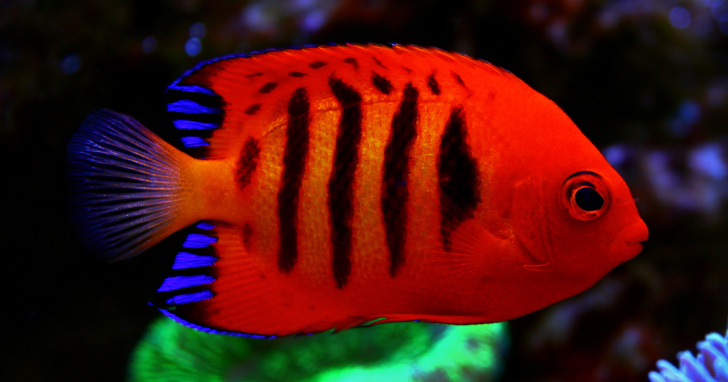
The Flame AngelfishSparking a Passion for Fiery Colored Saltwater Fish The Flame Angelfish Centropyge loricula is one of the most recognizable Dwarf Angelfish. In nature it makes its home among clear lagoons and seaward reefs in tropical waters with plenty of areas to hide. It feeds on algae and small inverts found in its environment. It is an extremely popular marine fish in the aquarium trade. Other names this prized marine fish is known by include the Flaming Angelfish and Japanese Pygmy Angelfish. There are slight differences in both coloration and markings of this species based on the location of collection. Generally, Flame Angelfish from the Central Pacific (Marshall Islands and Christmas Island) have a fiery red orange body and a series of thick black bars resembling flames that display horizontally across their bodies. They have an orange caudal fin, and dorsal and anal fins that are tinged with purplish blue and short horizontal black bars. Males of this species are typically slightly larger, with brighter coloration and more color in the caudal fins. Some varieties from Cebu and Tahiti may have a tint of yellow. When properly acclimated, these marine fish are hardy and can live up to seven years in an aquarium if they have a stable and healthy environment. They are protogynous hermaphrodites, so the dominant female will turn into a male in the absence of another male in the aquarium. Why are Flame Angelfish so expensive?
Availability and shipping costs vary depending on the different areas of the world from which they are collected. How aggressive are Flame Angelfish?
True to its Angelfish disposition, Flame Angelfish can become territorial, especially among conspecifics. They can live alone, in pairs, or a small harem of two to seven individuals. Caretakers should select peaceful tankmates that won't compete with the Flame Angel for food and avoid aggressive species that could cause stress or potential harm. Are Flame Angelfish reef safe?
They should be fed sufficiently, so they are not tempted to nibble or nip at stony and soft corals, sessile invertebrates, and clam mantles. They are reef safe with caution or great for Fish Only With Live Rock (FOWLR) marine aquariums. Centropyge loricula should be introduced into a mature saltwater or reef system with live rock on which they can graze for algae and be provided places to hide. How big do Flame Angelfish get?
Flame Angelfish grow to a length of four inches and require an aquarium of at least seventy gallons. What are the care requirements for Flame Angelfish?
The temperature of the aquarium should be between 72-78° F, the specific gravity at 1.020-1.025, the dkH of 8-12, and a pH range of 8.1-8.4. Caretakers should know that Flame Angelfish are sensitive to copper and should never be exposed to levels near or above 0.15 ppm. Can I breed Flame Angelfish at home?
Flame Angelfish are difficult to breed in a home aquarium. What do Flame Angelfish eat?
In addition to the algae they graze on that is found in their environment, it is important to sufficiently feed the Flame Angelfish to keep them from disturbing stony and soft corals or clam mantles. Their diet should consist of both herbaceous and meaty foods, in smaller amounts fed throughout the day. This member of the Pomacanthidae family is an omnivore and requires a diet of Spirulina, marine algae, high-quality Angelfish preparations, Mysis or frozen shrimp, and other high quality meaty items. In Closing
Whether aquarists plan on housing Flame Angelfish in a saltwater, FOWLR, or reef aquarium, they will be highly rewarded because of the sheer attractiveness of this species. With this popular marine fish on the “wish list” of so many saltwater aquarium owners, it is no surprise that they sell out quickly when they become available. Related Articles
|
|
|


